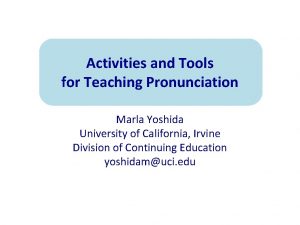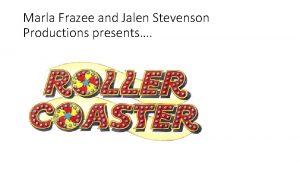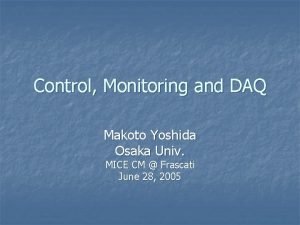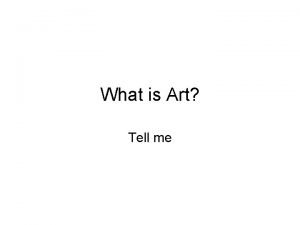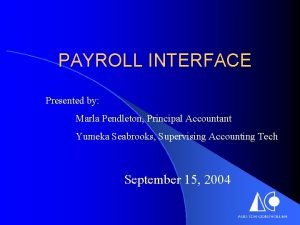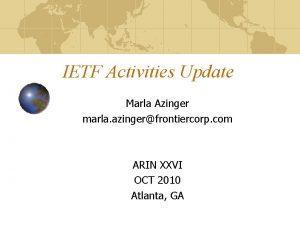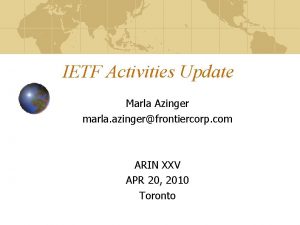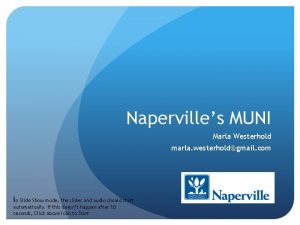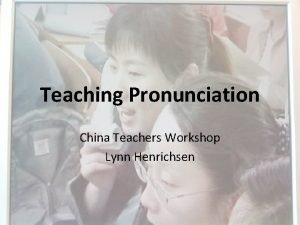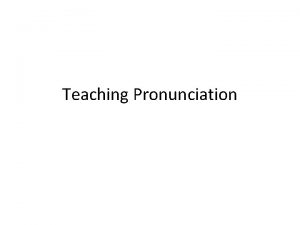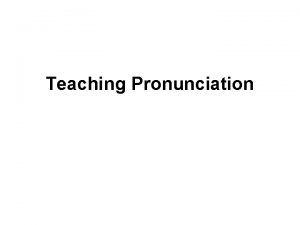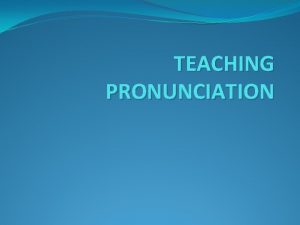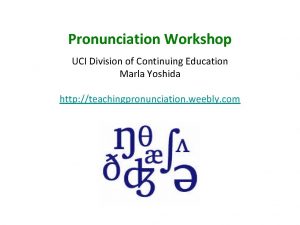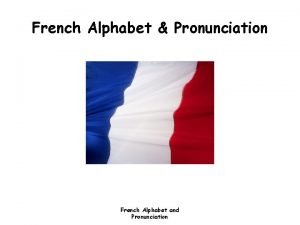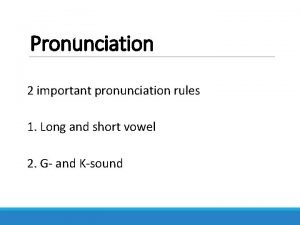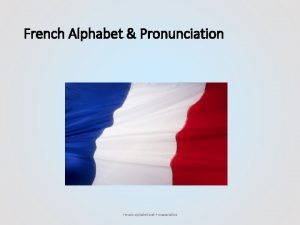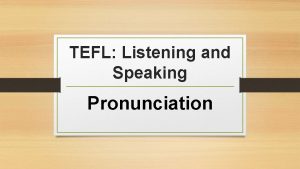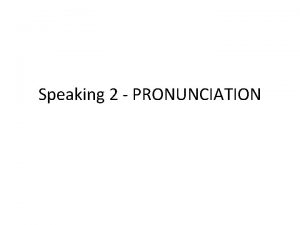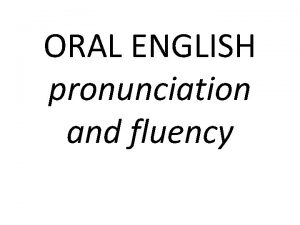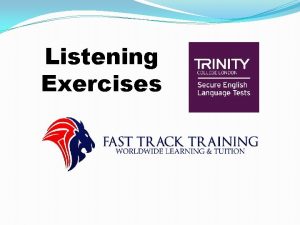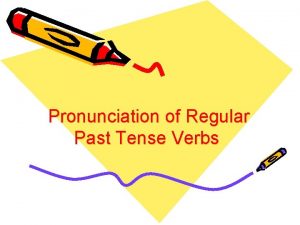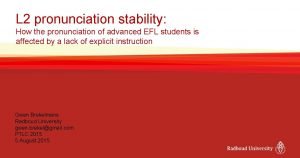Activities and Tools for Teaching Pronunciation Marla Yoshida






































- Slides: 38

Activities and Tools for Teaching Pronunciation Marla Yoshida University of California, Irvine Division of Continuing Education yoshidam@uci. edu

Overview u Teaching the pronunciation of sounds u Teaching the musical aspects of pronunciation

How can we help learners reach their pronunciation goals? u Provide information u Provide practice u Provide feedback It’s a continuous process.

How? u u u “Repeat after me” is useful, but it’s not enough for successful pronunciation learning. Do more than simply teach rules and use mechanical drills. Use a variety of techniques—sound, sight, movement, and meaningful activities.

Pronunciation teaching includes… u u Individual sounds (consonants and vowels) The musical aspects of pronunciation, such as • Syllables and word stress • Thought groups and pauses • Prominence and intonation • Connected speech

Teaching sounds u When explaining about pronunciation: K. I. S. S. = Keep it short and simple! u u It’s not enough to just explain how to say a sound. We also need to show—in more than one way. Learning pronunciation takes time. Students need to practice a lot and create muscle memory.

Modeling pronunciation of sounds u u Demonstrations by the teacher Sagittal section diagrams (“Sammy diagrams”)

Modeling pronunciation of sounds Sounds of Speech (Univ. of Iowa) http: //soundsofspeech. uiowa. edu Websites and Apps The Phonetics http: //d 3492 jnbjg 00 z 1. cloudfront. net/

Modeling pronunciation of sounds A dental model and “tongue puppet” are useful in showing how some sounds are produced.

Activities for practicing sounds Move from simple to more difficult; don’t rush it! u Very controlled practice

Activities for practicing sounds Move from simple to more difficult; don’t rush it! u Guided practice u Very controlled practice

Activities for practicing sounds Move from simple to more difficult; don’t rush it! u Communicative practice u Guided practice u Very controlled practice

Very controlled practice Words, sentences, minimal pairs, and dialogues (There are lots of /r/ and /l/ sounds in this one. ) Lisa: I wish I had a driver’s license. I’m so tired of taking the bus or asking my friends for a ride. Rob: Me too. Every time I want to go to the store I have to ask my roommate to take me. Lisa: Your roommate has a car? You’re so lucky!

Minimal pairs What can you do with minimal pairs? u u Listen and repeat 1. think Which one am I saying? § Both sight and sound 2. sink § Sound only § Sight only Have students practice with each other Have students write sentences to practice using both words: “I think the sink is broken. ”

Guided practice: A simple info gap

Communicative practice u u To be practical, learners need to be able to use pronunciation in real speaking. That’s why we need communicative practice too—to build fluency as well as accuracy. Students don’t always realize that speaking practice can also be pronunciation practice.

Communicative practice

The musical aspects of pronunciation Pronunciation is more than just sounds. For example, learners also need to know about: u Syllables and word stress u Thought groups and pauses u Prominence and intonation u Connected speech

We can practice these in many ways: Through sight, sound, and meaningful activities movement,

Syllables and word stress How many syllables do these words have? How many might learners think they have? u cat u responsibility u spring u chocolate

Syllables and word stress How many syllables do these words have? How many might learners think they have? Why? u cat 1 u responsibility re • spon • si • bi • li • ty 6 u spring 1 u chocolate / choc • olate 2 (generally)

Teaching word stress u u When you teach new vocabulary, count syllables and practice stress patterns. Mark word stress with movement: Clap, tap, stomp, or nod. Open and close your hand. Stretch a rubber band.

Build syllable models TEACH er con gra tu LA tions

Thought groups Pausing between meaningful chunks of words makes speech easier to understand. These chunks are called “thought groups. ” You can lead a horse to water, / but you can’t make him drink.

Prominence In each thought group, there’s usually one prominent word that’s stressed more than the rest. Often it’s the last content word. You can lead a horse to water, / but you can’t make him drink.

Prominence can change meaning. u You can lead a horse to water.

Mark prominence with movement u u u Punch the air, tap, or stomp Stretch your hands apart or stretch a rubber band Nod your head or bend your knees

Intonation is the up-and-down melody of your voice as you speak. You can lead a horse to water, / but you can’t make him drink.

Ways to practice intonation u u Make a pipe-cleaner model Make a human intonation model Conduct an intonation orchestra Imitate intonation with a kazoo, or just hum

Connected Speech We don’t speak in strings of separate words: Spoken words are like magnets, all stuck together:

Raise awareness of connected speech u u u Connect magnets or blocks with Velcro on the end Grasp hands together Use dictations to practice interpreting connected speech

Dictations to practice connected speech 1. Where do you want to have lunch? 2. Would you like soup or salad with that? u What words were hard for you to hear? u Why do you think they were hard to hear?

Dictations to practice connected speech 1. Where do you want to have lunch? 2. Would you like soup or salad with that? u What words were hard for you to hear? u Why do you think they were hard to hear?

Meaningful, communicative activities u Shadowing u Drama and role plays u Storytelling and creative projects

Creative pronunciation projects u Adobe Spark https: //spark. adobe. com/ or as an app

Creative pronunciation projects u Voki http: //www. voki. com/ or as an app

Questions?

Contact Information Thank you for listening. Let me know if you have any questions or comments: Marla Yoshida yoshidam@uci. edu http: //teachingpronunciation. weebly. com Beyond Repeat After Me: Teaching Pronunciation to English Learners TESOL Press
 Marla yoshida
Marla yoshida Roller coaster by marla frazee activities
Roller coaster by marla frazee activities Ko ni chi wa
Ko ni chi wa Ruriko yoshida
Ruriko yoshida Adriana yoshida
Adriana yoshida Makoto yoshida
Makoto yoshida Marla strecker
Marla strecker Fcpa third party due diligence checklist
Fcpa third party due diligence checklist Marla olmstead
Marla olmstead Marla pendleton
Marla pendleton Marla michaels
Marla michaels Now group these activity into indoor and outdoor activities
Now group these activity into indoor and outdoor activities Primary and support activities
Primary and support activities Primary and secondary activities
Primary and secondary activities Scaled down teaching meaning
Scaled down teaching meaning Introduction to teaching pronunciation
Introduction to teaching pronunciation Operating activities vs investing activities
Operating activities vs investing activities Meaning of remedial teaching
Meaning of remedial teaching Grammatical signals
Grammatical signals What is direct method
What is direct method Kontinuitetshantering i praktiken
Kontinuitetshantering i praktiken Typiska drag för en novell
Typiska drag för en novell Nationell inriktning för artificiell intelligens
Nationell inriktning för artificiell intelligens Returpilarna
Returpilarna Varför kallas perioden 1918-1939 för mellankrigstiden?
Varför kallas perioden 1918-1939 för mellankrigstiden? En lathund för arbete med kontinuitetshantering
En lathund för arbete med kontinuitetshantering Kassaregister ideell förening
Kassaregister ideell förening Personlig tidbok fylla i
Personlig tidbok fylla i A gastrica
A gastrica Densitet vatten
Densitet vatten Datorkunskap för nybörjare
Datorkunskap för nybörjare Boverket ka
Boverket ka Debattinlägg mall
Debattinlägg mall För och nackdelar med firo
För och nackdelar med firo Nyckelkompetenser för livslångt lärande
Nyckelkompetenser för livslångt lärande Påbyggnader för flakfordon
Påbyggnader för flakfordon Tryck formel
Tryck formel Publik sektor
Publik sektor Jag har nigit för nymånens skära
Jag har nigit för nymånens skära
